Estimating the Spatial Heterogeneity and Seasonal Differences of the Contribution of Tourism Industry Activities to Night Light Index by POI
Abstract
:1. Introduction
2. Materials and Methods
2.1. Study Area
2.2. Data Sources
2.2.1. Spatial and Night Lighting Data
2.2.2. POI Date
2.3. Data and Image Processing
2.3.1. Image Correction
2.3.2. Calculation of Night Light Index
2.3.3. Deletion of POI Data
2.4. Applied Method
2.4.1. OLS Regression Analysis
2.4.2. Geographically Weighted Regression Analysis
3. Results
3.1. Results of OLS Model
3.2. Results of GWR Model
4. Discussion
5. Conclusions
Author Contributions
Funding
Institutional Review Board Statement
Informed Consent Statement
Data Availability Statement
Conflicts of Interest
References
- World Tourism Organization. International Tourism Highlights, 2019th ed.; UNWTO: Madrid, Spain, 2019; p. 2. [Google Scholar] [CrossRef]
- Feng, X.; Xia, J. Evaluation of China’s global tourism development level and its spatial characteristics. Econ. Geogr. 2018, 38, 183–192. (In Chinese) [Google Scholar] [CrossRef]
- Li, X.; Zhang, L.; Cui, L. Global Tourism: Conceptual Innovation for Building a World-Class Tourist Destination: Taking Beijing as an Example. Human Geogr. 2013, 28, 130–134. (In Chinese) [Google Scholar] [CrossRef]
- Guiding Opinions of the General Office of the State Council on Promoting the Development of Tourism in the Whole Region. Available online: http://www.gov.cn/zhengce/content/2018-03/22/content_5276447.htm (accessed on 19 November 2021). (In Chinese)
- Notice of the General Office of Hunan Provincial People’s Government on Printing and Distributing the Three-Year Action Plan for Building a Global Tourism Base in Hunan Province (2018–2020). Available online: http://www.hunan.gov.cn/xxgk/wjk/szfbgt/201807/t201807135051854.html. (accessed on 19 November 2021). (In Chinese)
- Notice on Printing and Distributing the Action Plan for Promoting the High-Quality Development of Tourism in Hunan Province During the 14th Five Year Plan Period. Available online: http://whhlyt.hunan.gov.cn//whhlyt/xxgk2019/xxgkml/tzgg/202109/t20210902_20456638.html (accessed on 19 November 2021). (In Chinese)
- Niccolò, C.; Fernanda, S. Tourism and its economic impact: A literature review using bibliometric tools. Tour. Econ. 2019, 25, 109–131. [Google Scholar] [CrossRef]
- Kai, K.; Fuchs, M. Aligning tourism’s socio-economic impact with the United Nations’ sustainable development goals. Tour. Manag. Perspect. 2021, 39, 100831. [Google Scholar] [CrossRef]
- Krikigianni; Tsiakos; Chalkias. Estimating the relationship between touristic activities and night light emissions. Eur. J. Remote Sens. 2019, 52 (Supp. S1), 233–246. [Google Scholar] [CrossRef] [Green Version]
- Tan, Z.; Guan, Q.; Lin, J.; Yang, L.; Luo, H.; Ma, Y.; Tian, J.; Wang, Q.; Wang, N. Measuring urban compactness based on functional characterization and human activity intensity by integrating multiple geospatial data sources. Ecol. Indic. 2021, 121, 107177. [Google Scholar] [CrossRef]
- Zhong, Y.; Su, Y.; Wu, S.; Zheng, Z.; Zhao, J.; Ma, A.; Zhu, Q.; Ye, R.; Li, X.; Pellikka, P.; et al. Open-source data-driven urban land-use mapping integrating point-line-polygon semantic objects: A case study of Chinese cities. Remote Sens. Environ. 2020, 247, 111838. [Google Scholar] [CrossRef]
- Yan, S.; Knaap, G.J. Measuring the effects of mixed land uses on housing values. Reg. Sci. Urban Econ. 2004, 34, 663–680. [Google Scholar] [CrossRef]
- Santos, F.; Almeida, A.; Martins, C.; Gonçalves, R.; Martins, J. Using POI functionality and accessibility levels for delivering personalized tourism recommendations. Comput. Environ. Urban 2019, 77, 101173. [Google Scholar] [CrossRef]
- Lin, L.; Lei, Y. Validity method of public participation point of interest data. Sci. Surv. Mapp. 2015, 40, 98–103. (In Chinese) [Google Scholar] [CrossRef]
- Henderson, M.; Yeh, E.; Gong, P.; Elvidge, C.; Baugh, K. Validation of urban boundaries derived from global night-time satellite imagery. Int. J. Remote Sens. 2003, 24, 595–609. [Google Scholar] [CrossRef]
- Chen, Z.; Yu, B.; Ta, N.; Shi, K.; Yang, C.; Wang, C.; Zhao, X.; Deng, S.; Wu, J. Delineating Seasonal Relationships Between Suomi NPP-VIIRS Nighttime Light and Human Activity Across Shanghai, China. IEEE J. Stars 2019, 12, 1–9. [Google Scholar] [CrossRef]
- Xia, C.; Yeh, G.O.; Zhang, A. Analyzing spatial relationships between urban land use intensity and urban vitality at street block level: A case study of five Chinese megacities. Landsc. Urban Plan 2020, 193, 103669. [Google Scholar] [CrossRef]
- Elvidge, C.D.; Baugh, K.E.; Anderson, S.; Sutton, P.; Ghosh, T. The Night Light Development Index (NLDI): A spatially explicit measure of human development from satellite data. Soc. Geogr. Discuss. 2012, 7, 23–35. [Google Scholar] [CrossRef]
- Yue, W.; Gao, J.; Yang, X. Estimation of Gross Domestic Product Using Multi-Sensor Remote Sensing Data: A Case Study in Zhejiang Province, East China. Remote Sens. 2014, 6, 7260–7275. [Google Scholar] [CrossRef] [Green Version]
- Shi, K.; Huang, C.; Yu, B.; Yin, B.; Huang, Y.; Wu, J. Evaluation of NPP-VIIRS night-time light composite data for extracting built-up urban areas. Remote Sens. Lett. 2014, 5, 358–366. [Google Scholar] [CrossRef]
- Lu, D.; Wang, Y.; Yang, Q.; Su, K.; Zhang, H.; Li, Y. Modeling Spatiotemporal Population Changes by Integrating DMSP-OLS and NPP-VIIRS Nighttime Light Data in Chongqing, China. Remote Sens. 2021, 13, 284. [Google Scholar] [CrossRef]
- Chalkias, C.; Petrakis, M.; Psiloglou, B.; Lianou, M. Modelling of light pollution in suburban areas using remotely sensed imagery and GIS. J. Environ. Manag. 2006, 79, 57–63. [Google Scholar] [CrossRef] [PubMed]
- Falchi, F.; Cinzano, P.; Duriscoe, D.; Kyba, C.C.M.; Elvidge, C.D.; Baugh, K.; Portnov, B.A.; Rybnikova, N.A.; Furgoni, R. The new world atlas of artificial night sky brightness. Sci. Adv. 2016, 2, e1600377. [Google Scholar] [CrossRef] [Green Version]
- Small, C.; Pozzi, F.; Elvidge, C.D. Spatial analysis of global urban extent from DMSP-OLS night lights. Remote Sens. Environ. 2005, 96, 277–291. [Google Scholar] [CrossRef]
- Elvidge, C.D.; Zhizhin, M.; Baugh, K.; Hsu, F.-C.; Ghosh, T. Methods for Global Survey of Natural Gas Flaring from Visible Infrared Imaging Radiometer Suite Data. Energies 2015, 9, 14. [Google Scholar] [CrossRef]
- Elvidge, C.D.; Baugh, K.; Zhizhin, M.; Hsu, F.C.; Ghosh, T. VIIRS night-time lights. Int. J. Remote Sens. 2017, 38, 5860–5879. [Google Scholar] [CrossRef]
- Steven, M.; William, S.; Stephen, M.; Miller, S.D.; Straka, W.; Mills, S.P.; Elvidge, C.D.; Lee, T.F.; Solbrig, J.; Walther, A.; et al. Illuminating the Capabilities of the Suomi National Polar-Orbiting Partnership (NPP) Visible Infrared Imaging Radiometer Suite (VIIRS) Day/Night Band. Remote Sens. 2013, 5, 6717–6766. [Google Scholar] [CrossRef] [Green Version]
- Khalik, W.; Zhu, Y.; He, C. Viewing the development of China’s tourism economy and its spatial spillover effects from night lights: An empirical study based on the spatial panel measurement model. Ecol. Econ. 2018, 34, 126–131. (In Chinese) [Google Scholar]
- Nie, Y.; Lan, T.; Yu, M. Scenic Sites Selection in Dark-Sky Park Based on NPP/VIIRS: A Case Study in Fujian Province. Procedia Comput. Sci. 2019, 154, 798–805. [Google Scholar] [CrossRef]
- Li, M.; Cai, W. NPP/VIIRS multi-temporal luminous remote sensing image correction method. Bull. Surv. Mapp. 2019, 7, 122–126. (In Chinese) [Google Scholar] [CrossRef]
- Hu, W.; Liu, C.; Zhan, Q. Synthesis method and comparative verification of annual night light data of NPP-VIIRS in China. J. Guilin Univ. Technol. 2021, 41, 141–148. (In Chinese) [Google Scholar]
- Ma, T.; Zhou, C.; Pei, T.; Haynie, S.; Fan, J. Responses of Suomi- NPP VIIRS- derived nighttime lights to socioeconomic activity in China’s cities. Remote Sens. Lett. 2014, 5, 165–174. [Google Scholar] [CrossRef]
- Zhou, Y.; Chen, Y.; Liu, Y.; Tian, F.; Yi, X. The synthesis method and verification of NPP-VIIRS annual night light data. Remote Sens. Inform. 2019, 34, 62–68. (In Chinese) [Google Scholar]
- Stone, M.; Brooks, R.J. Continuum Regression: Cross-Validated Sequentially Constructed Prediction Embracing. J. R. Stat. Soc. B 1990, 52, 237–269. [Google Scholar] [CrossRef]
- Brunsdon, C.; Fotheringham, A.S.; Charlton, M.E. Geographically weighted regression: A method for exploring spatial nonstationarity. Geogr. Anal. 1996, 28, 281–298. [Google Scholar] [CrossRef]
- Griffith, D.A. Spatial-filtering-based contributions to a critique of geographically weighted regression (GWR). Environ. Plann. A 2008, 40, 2751–2769. [Google Scholar] [CrossRef]
- Fotheringham, A.S.; Oshan, T.M. Geographically weighted regression and multicollinearity: Dispelling the myth. J. Geogr. Syst. 2016, 18, 303–329. [Google Scholar] [CrossRef]
- Cho, S.H.; Lambert, D.M.; Chen, Z. Geographically weighted regression bandwidth selection and spatial autocorrelation: An empirical example using Chinese agriculture data. Appl. Econ. Lett. 2010, 17, 767–772. [Google Scholar] [CrossRef]
- Liu, Z. Akaike information criterion AIC and its significance. J. Math. Prac. Theory 1980, 64–72. (In Chinese) [Google Scholar]
- Fotheringham, A.S.; Brunsdon, C. Local Forms of Spatial Analysis. Geogr. Anal. 2010, 31, 340–358. [Google Scholar] [CrossRef]
- Feng, Y.; Tong, X. Incorporation of spatial heterogeneity-weighted neighborhood into cellular automata for dynamic urban growth simulation. Gisci. Remote Sens. 2019, 56, 1024–1045. [Google Scholar] [CrossRef]
- Moreno, N.; Fang, W.; Marceau, D.J. Implementation of a dynamic neighborhood in a land-use vector-based cellular automata model. Comput. Environ. Urban. 2009, 33, 44–54. [Google Scholar] [CrossRef]
- Feng, Y.; Tong, X. Dynamic land use change simulation using cellular automata with spatially nonstationary transition rules. Gisci. Remote Sens. 2018, 55, 678–698. [Google Scholar] [CrossRef]
- Huang, B.; Wu, B.; Barry, M. Geographically and temporally weighted regression for modeling spatio-temporal variation in house prices. Int. J. Geogr. Inf. Sci. 2010, 24, 383–401. [Google Scholar] [CrossRef]
- Su, S.; Li, D.; Hu, Y.; Xiao, R.; Zhang, Y. Spatially non-stationary response of ecosystem service value changes to urbanization in Shanghai, China. Ecol. Indic. 2014, 45, 332–339. [Google Scholar] [CrossRef]
- Lin, Y. Research on the host-guest relationship in ethnic tourism from the perspective of social interaction: Taking Nangang Yaozhai as an example. J. Chengdu. Univ. Technol. 2019, 22, 63–67. (In Chinese) [Google Scholar] [CrossRef]
- Dong, K.; Zhang, W. Choice of travel modes for tourists in mountainous scenic spots. Trans. Technol. Econ. 2011, 13, 1–4. (In Chinese) [Google Scholar] [CrossRef]
- Shao, C.; Guo, J.; Lv, K.; Li, X. Research on weekend passenger traffic characteristics of cultural and tourism scenic spots. J. Wuhan Univ. Technol. 2020, 42, 91–96. (In Chinese) [Google Scholar]
- Yang, W.; Wang, W. Research on the Integrated Development of Transportation and Tourism Industry in Kunshan City. Trans. Enter. Manag. 2019, 34, 10–13. (In Chinese) [Google Scholar]
- Lin, C.H. Transactional versus relational patronizing intentions. Ann. Tour. Res. 2009, 36, 726–730. [Google Scholar] [CrossRef]
- Chu, E.; Liu, A.; Wang, R.; Cheng, W. Rethinking Tourism Seasonality under the Background of Global Tourism. J. Cap. Norm. Univ. Nat. Sci. Ed. 2021, 42, 84–90. (In Chinese) [Google Scholar] [CrossRef]
- Tom, B.; Laura, H. Responses to seasonality: The experiences of peripheral destinations. Int. J. Tour. Res. 1999, 1, 299–312. [Google Scholar] [CrossRef]
- Liu, J.; Zhao, J.; Zhang, G. A spatial econometric analysis of the relationship between China’s tourism industry agglomeration and tourism economic growth. Econ. Geogr. 2013, 33, 186–192. (In Chinese) [Google Scholar]
- Hu, W.; Chen, P. An Empirical Analysis of the Competitiveness of Urban Tourism in Hunan Province Based on Factor Analysis. Mark. Forum 2018, 9, 16–23. (In Chinese) [Google Scholar]
- Cheng, P.; Han, J.; Wu, J.; Guo, M. Spatial and temporal evolution analysis of urban leisure tourism based on multi-source data——Taking Nanchang as an example. J. Guilin Univ. Technol. 2021, 41, 362–369. (In Chinese) [Google Scholar]
- Wu, Z.; Wu, C. Study on tourism resources and their development and utilization in Hunan. J. Cent. South Univ. For. Sci. Technol. 2003, 23, 1–5. (In Chinese) [Google Scholar] [CrossRef]
- Zhong, L.; Yang, R.; Zhao, Z. Half of the National Park is Dark Night: The American Experience and Chinese Path of Dark Night Starry Sky Research. Landsc. Archit. 2019, 26, 85–90. (In Chinese) [Google Scholar] [CrossRef]
- Yue, C.; Ying, L.; Rui, Y. Research on the Identification and Spatial Distribution of Wilderness at the Land Scale of Mainland China. Chin. Gard. 2017, 33, 26–33. [Google Scholar]
- Krause, C.; Zhang, L. Short-term travel behavior prediction with GPS, land use, and point of interest data. Transpot. Resb. Meth. 2019, 123, 349–361. [Google Scholar] [CrossRef]
- Wei, Z.Y.; Su, H.M.; Huang, R.J. Analysis of Xi’an Commercial agglomeration characteristics based on POI data. J. Southwest Univ. Nat. Sci. 2020, 42, 97–104. (In Chinese) [Google Scholar] [CrossRef]
- Yang, Y.; Li, Y.J.; Huang, Q.X. Spatial temporal dynamic comparison of urban land use and population size distribution in China: A case study of Bohai Rim region. Geogr. Res. 2016, 35, 1672–1686. (In Chinese) [Google Scholar] [CrossRef]
- Wang, Y.; Hu, D.; Yu, C.; Di, Y.; Wang, S.; Liu, M. Appraising regional anthropogenic heat flux using high spatial resolution NTL and POI data: A case study in the Beijing-Tianjin-Hebei region, China. Environ. Pollut. 2022, 292, 118359. [Google Scholar] [CrossRef] [PubMed]
- Zheng, Q.; Weng, Q.; Wang, K. Developing a new cross-sensor calibration model for DMSP-OLS and Suomi- NPP VIIRS night-light imageries. ISPRS J. Photogramm. 2019, 153, 36–47. [Google Scholar] [CrossRef]
- Wang, J.J.; Ye, Y.Q.; Fang, F. Research on urban functional zoning based on kernel density and fusion data. Geogr. Geo-Inf. Sci. 2019, 35, 66–71. (In Chinese) [Google Scholar]
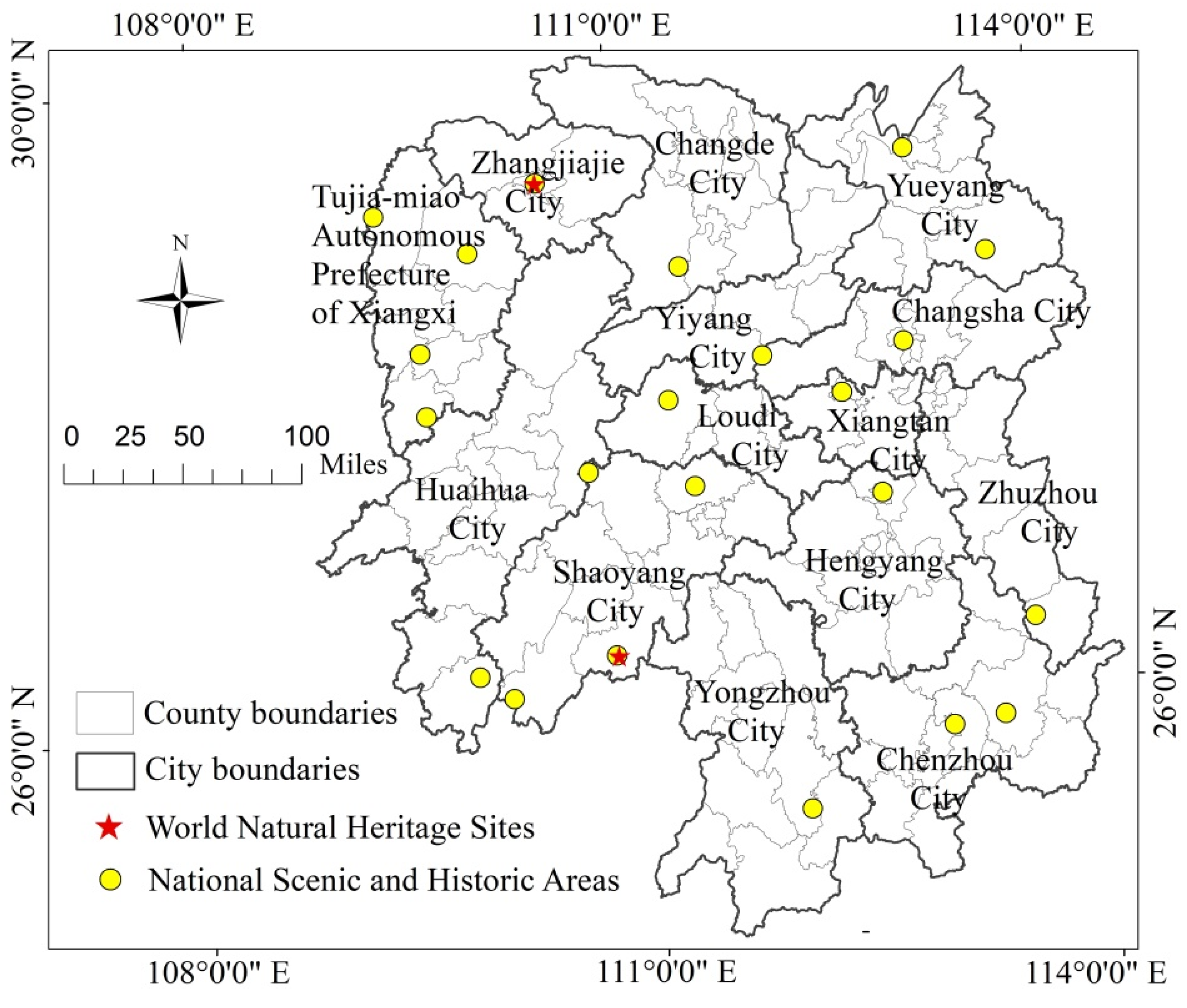
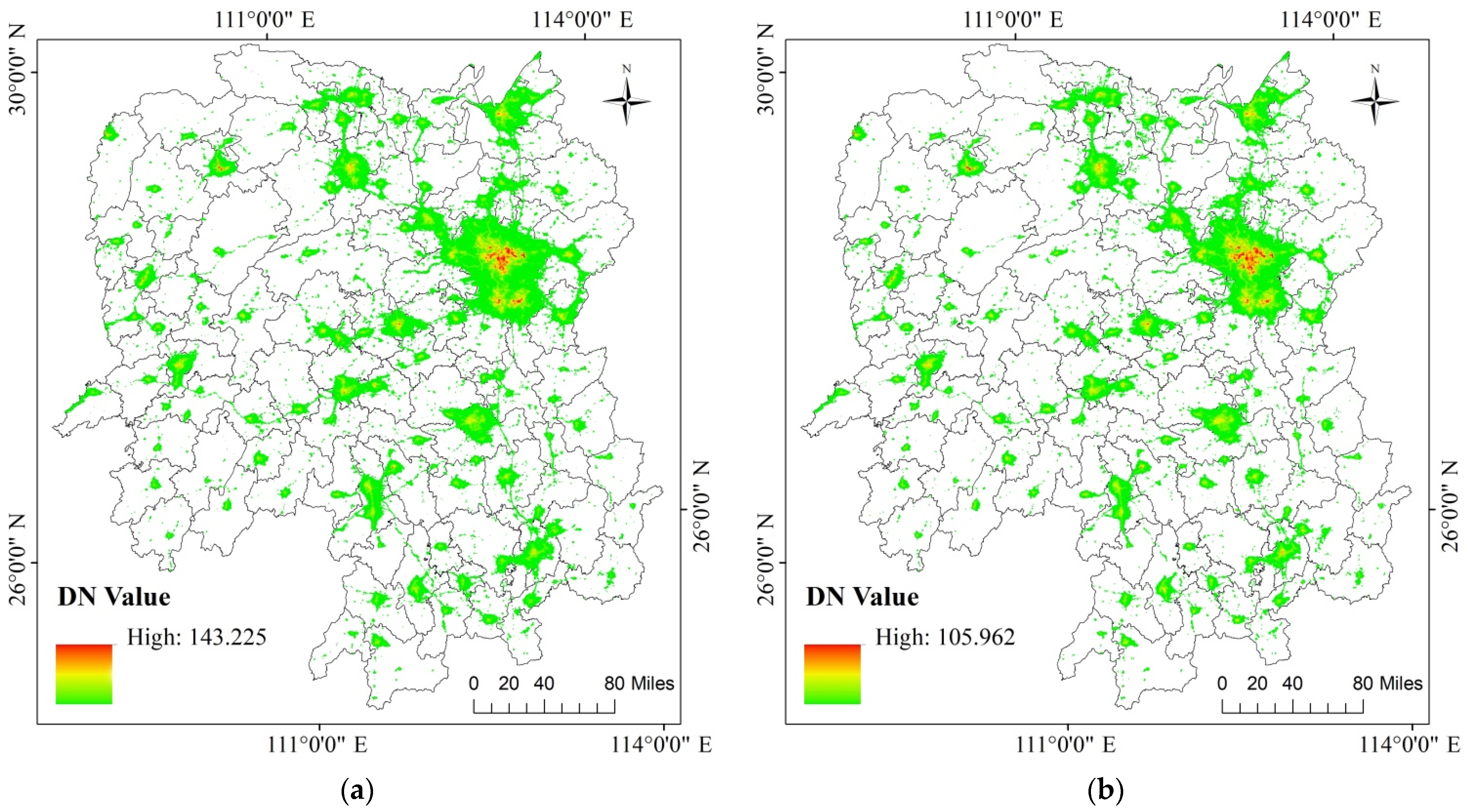
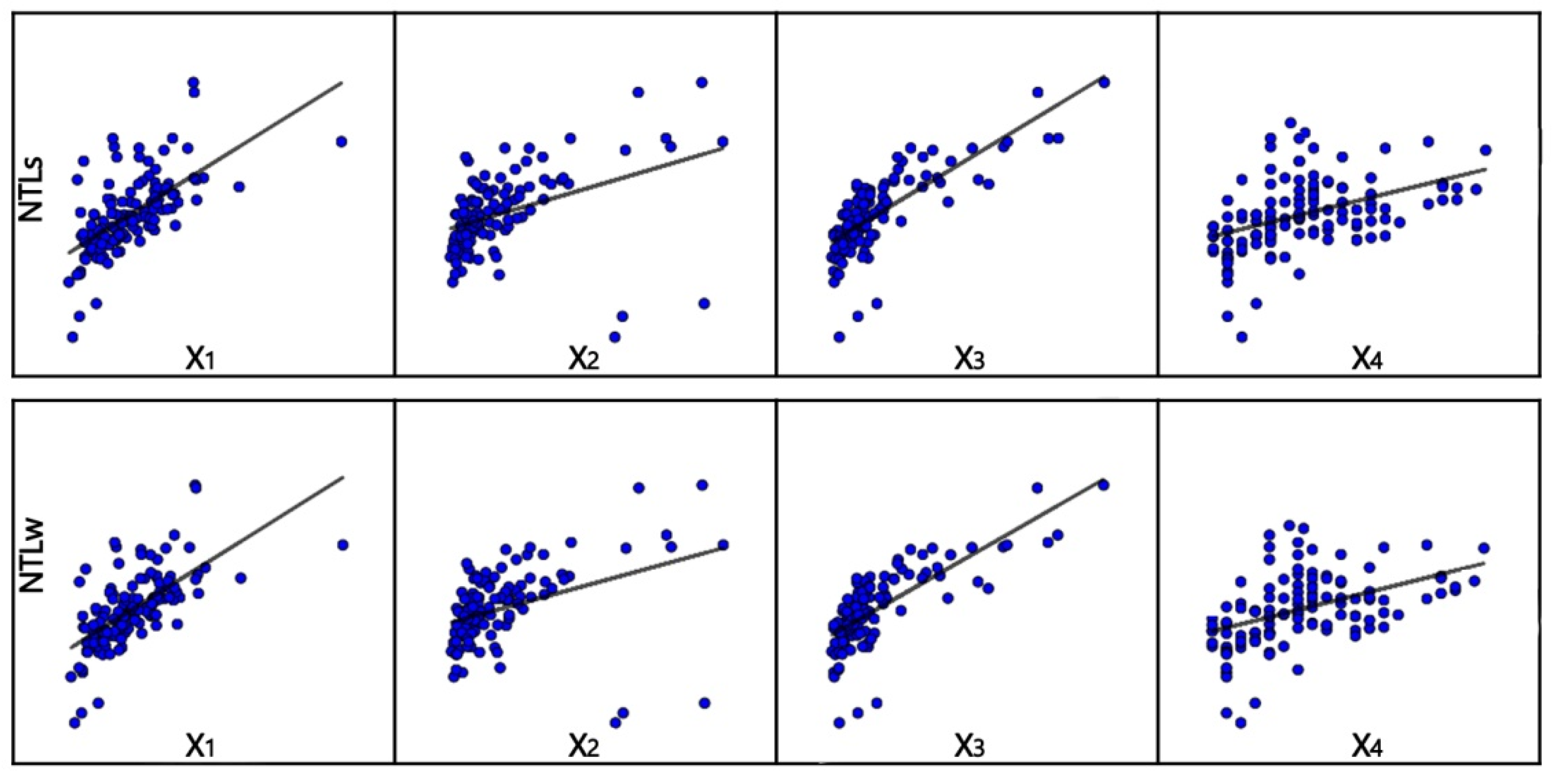
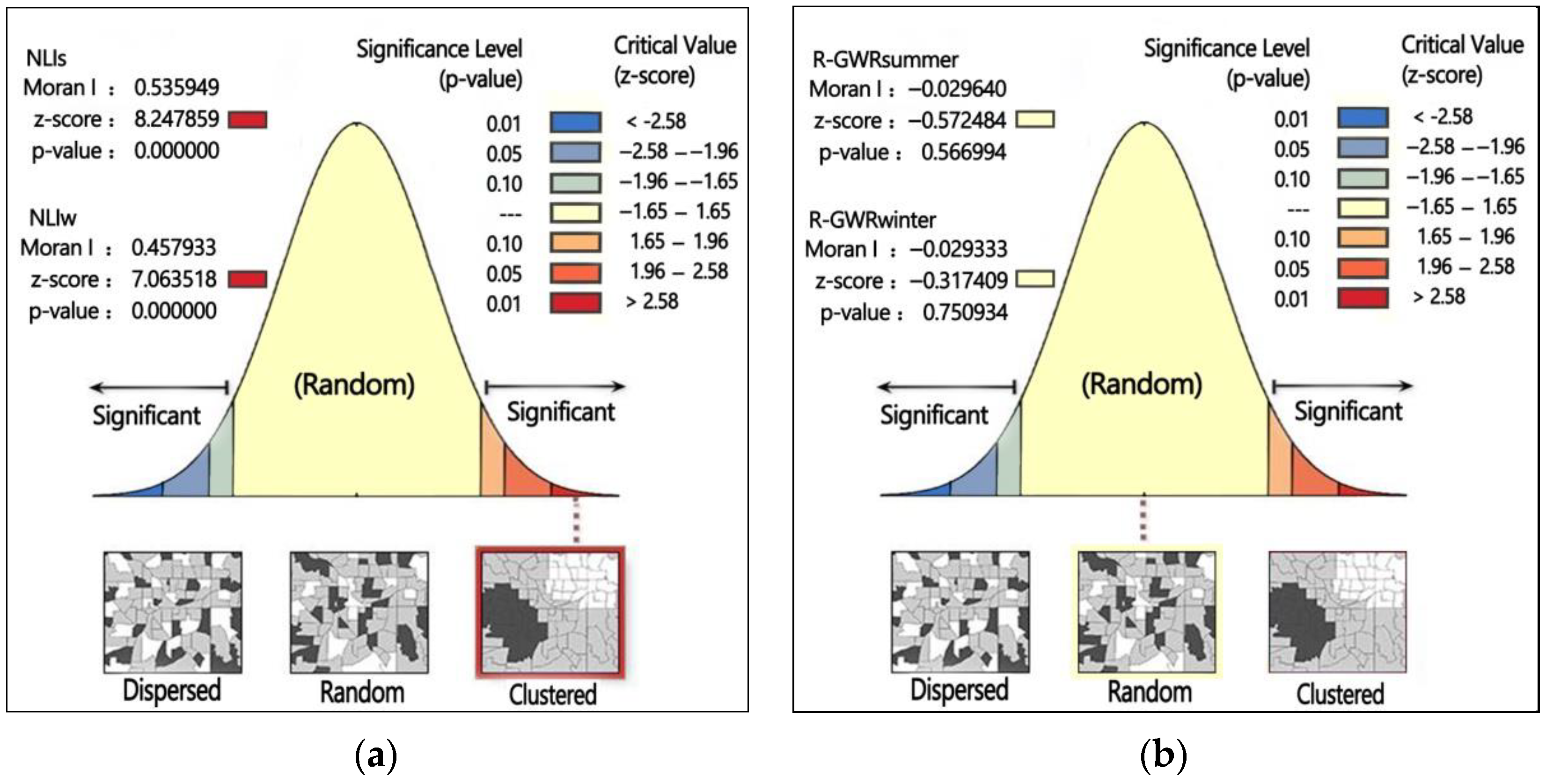

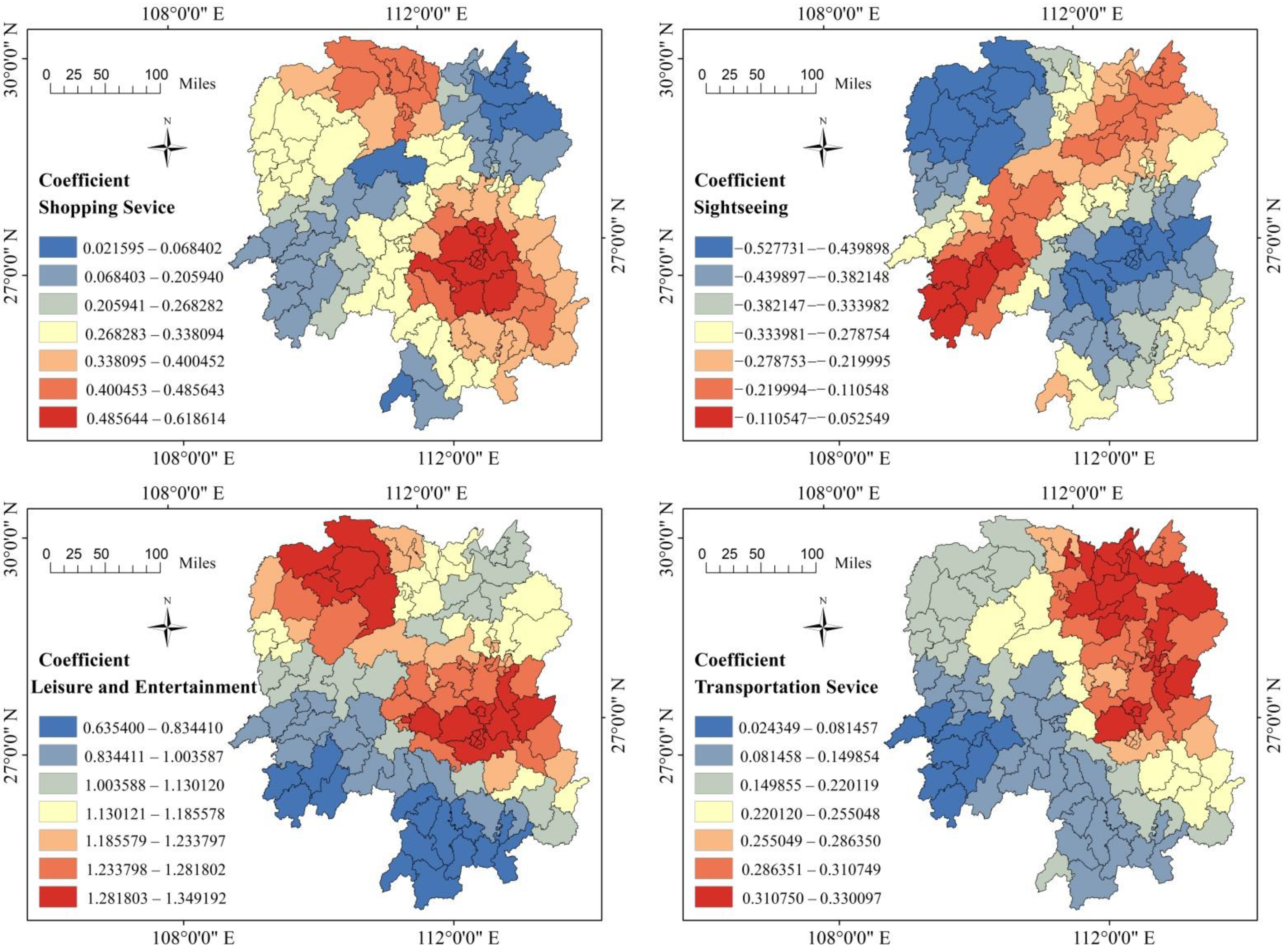
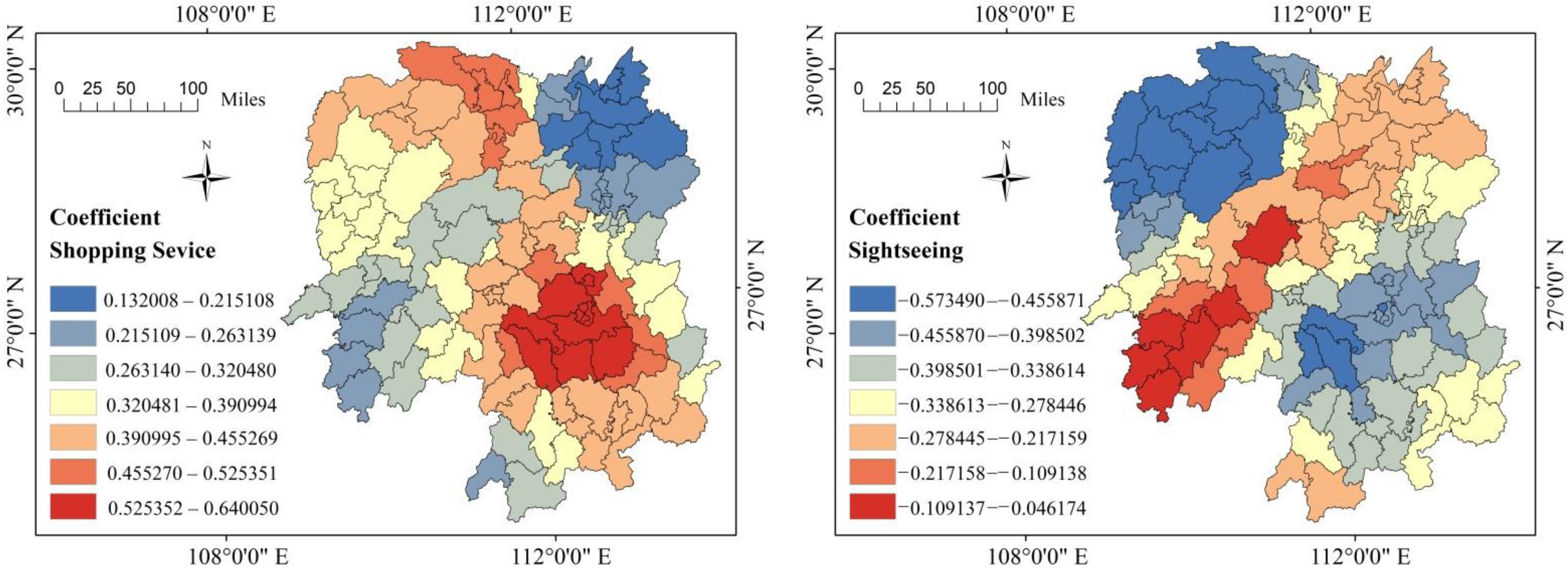

| Category | Quantity | Baidu POI Subcategory | |
|---|---|---|---|
| 1 | Catering service | 39,421 | Chinese restaurants, foreign restaurants, snack bars, cake dessert shops, coffee shops, teahouses, bars, other food shops |
| 2 | Accommodation service | 31,137 | Star hotels, express hotels, apartment hotels, home stay hotels, other hotels |
| 3 | Transportation service | 877 | Airports, train stations, coach stations |
| 4 | Sightseeing service | 13,126 | Sightseeing parks, zoos, botanical gardens, amusement parks, museums, aquariums, cultural relics, churches, scenic spots, temples |
| 5 | Shopping service | 52,964 | Shopping centers, department stores, supermarkets, convenience stores, small shops, markets, digital stores |
| 6 | leisure and Entertainment | 35,873 | Stadiums and gymnasiums, extreme sports venues, fitness centers, resorts, farmhouses, cinemas, KTV, theatres, song and dance halls, Internet cafes, game venues, leisure squares, bath massage shops, nursing homes, public toilets, special roads and post stations for cycling, ticket offices, some leisure parks, travel agencies, art galleries, exhibition halls, cultural palaces, libraries, science and technology museums, other leisure places |
| Variable | n | Kolmogorov Smirnov Z | Sig. (Bilateral) |
|---|---|---|---|
| NLIS | 122 | 0.780 | 0.577 |
| NLIW | 122 | 0.710 | 0.695 |
| Model | R2 | R2 Adjusted | Joint F Test | Sig | Koenker (BP) | Jarque-Bera | Durbin Watson |
|---|---|---|---|---|---|---|---|
| OLS summer | 0.763 | 0.755 | 94.341 | 0.000 | 10.575 | 1.341 | 1.948 |
| OLS winter | 0.759 | 0.751 | 92.067 | 0.000 | 18.248 | 2.616 | 1.942 |
| Model | Variable | Coefficient | Sig. | VIF |
|---|---|---|---|---|
| OLS summer | constant | 3.297 | 0.000 | |
| X1 | 0.507 | 0.000 | 1.894 | |
| X2 | −0.490 | 0.000 | 2.133 | |
| X3 | 1.300 | 0.000 | 2.246 | |
| X4 | 0.196 | 0.001 | 1.435 | |
| OLS winter | constant | 3.237 | 0.000 | |
| X1 | 0.566 | 0.000 | 1.894 | |
| X2 | −0.494 | 0.000 | 2.133 | |
| X3 | 0.233 | 0.000 | 2.246 | |
| X4 | 0.199 | 0.001 | 1.435 |
| Model | AICc | R2 | R2 Adjusted |
|---|---|---|---|
| OLS summer | −139.185 | 0.763 | 0.755 |
| GWR summer | −306.842 | 0.846 | 0.815 |
| OLS winter | −142.816 | 0.759 | 0.751 |
| GWR winter | −308.915 | 0.837 | 0.805 |
Publisher’s Note: MDPI stays neutral with regard to jurisdictional claims in published maps and institutional affiliations. |
© 2022 by the authors. Licensee MDPI, Basel, Switzerland. This article is an open access article distributed under the terms and conditions of the Creative Commons Attribution (CC BY) license (https://creativecommons.org/licenses/by/4.0/).
Share and Cite
Wei, J.; Zhong, Y.; Fan, J. Estimating the Spatial Heterogeneity and Seasonal Differences of the Contribution of Tourism Industry Activities to Night Light Index by POI. Sustainability 2022, 14, 692. https://doi.org/10.3390/su14020692
Wei J, Zhong Y, Fan J. Estimating the Spatial Heterogeneity and Seasonal Differences of the Contribution of Tourism Industry Activities to Night Light Index by POI. Sustainability. 2022; 14(2):692. https://doi.org/10.3390/su14020692
Chicago/Turabian StyleWei, Juan, Yongde Zhong, and Jingling Fan. 2022. "Estimating the Spatial Heterogeneity and Seasonal Differences of the Contribution of Tourism Industry Activities to Night Light Index by POI" Sustainability 14, no. 2: 692. https://doi.org/10.3390/su14020692
APA StyleWei, J., Zhong, Y., & Fan, J. (2022). Estimating the Spatial Heterogeneity and Seasonal Differences of the Contribution of Tourism Industry Activities to Night Light Index by POI. Sustainability, 14(2), 692. https://doi.org/10.3390/su14020692







